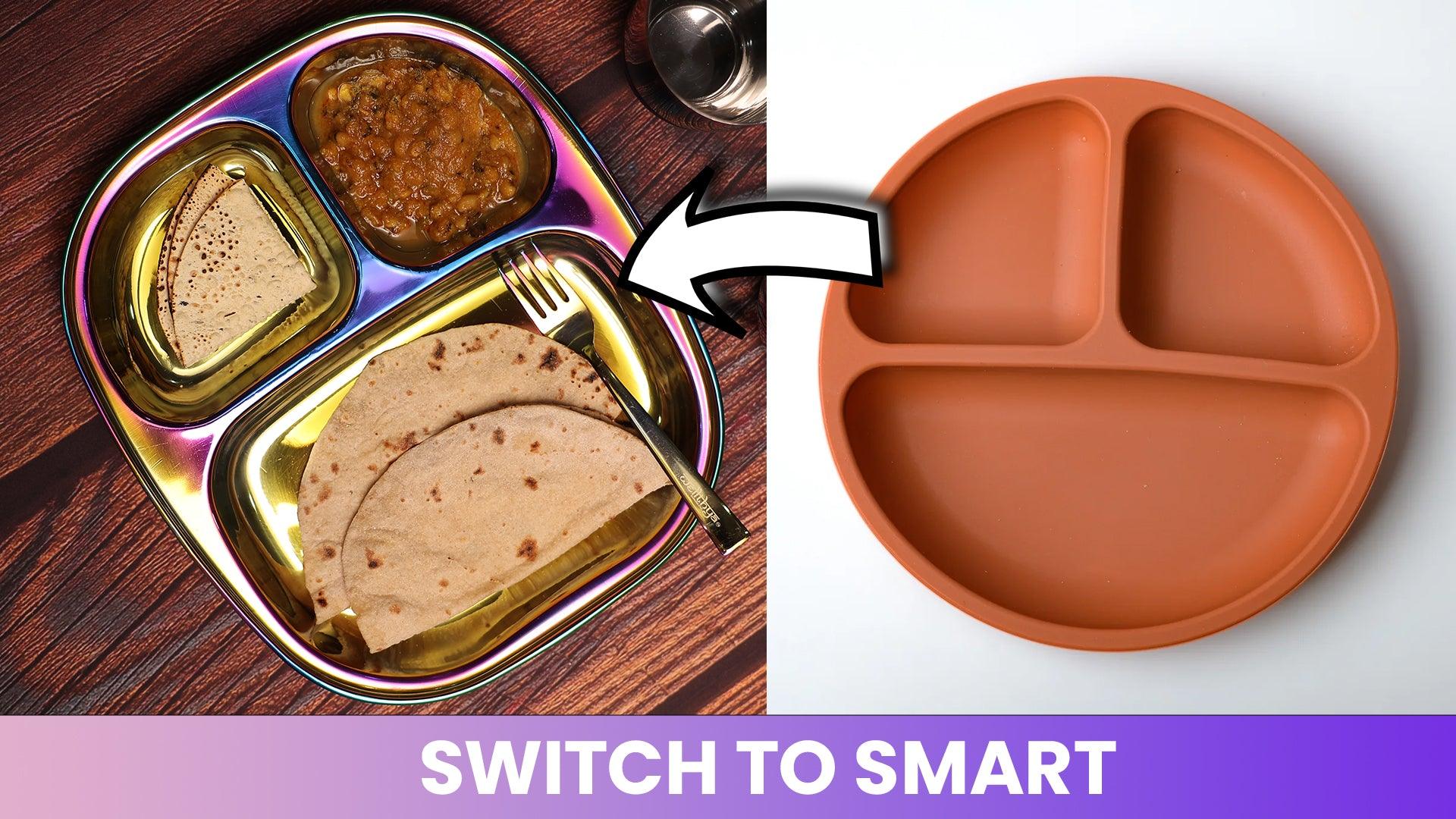When it comes to selecting dinnerware for your family, especially for children, safety and durability are paramount. In recent years, both stainless steel and silicone dinnerware have become popular choices due to their numerous benefits. This blog post will compare stainless steel and silicone dinnerware to help you determine which option best suits your family's needs.
What is Stainless Steel and Silicone Dinnerware?
- Stainless Steel Dinnerware: This type is made from iron alloys with added chromium and sometimes nickel, providing excellent durability and resistance to rust and corrosion.
- Silicone Dinnerware: Silicone is a rubber-like material made from silicon and oxygen. It's flexible, shatterproof, and increasingly used for kids' dishes and bakeware due to its heat resistance and safety features.
Comparison of Features:
|
Feature |
Stainless Steel |
Silicone |
|
Quality |
Consistently high quality; maintains integrity and appearance over time. |
Low quality and may degrade over time, especially with exposure to high temperatures and sharp objects. |
|
Durability |
Extremely durable, resistant to rust and denting. |
Flexible and shatterproof but may tear with sharp objects. |
|
Temperature Resistance |
Can withstand high temperatures; ideal for hot and cold foods. |
Heat resistant up to certain temperatures; can be used in microwaves and ovens. |
|
Maintenance |
Easy to clean, dishwasher safe, non-porous. |
Dishwasher safe, stain-resistant, but can retain odors if not cleaned properly. |
|
Cost |
Higher initial cost but lasts longer. |
Generally cheaper than stainless steel but may need replacement more frequently. |
|
Environmental Impact |
Highly recyclable and sustainable. |
Non-toxic and reusable, but recycling options are limited compared to metal. |
|
Aesthetic Appeal |
Sleek, modern look that does not fade. |
Available in a variety of colors and shapes, appealing to children. |
|
Safety |
Generally free from BPA and phthalates. Safe at high temperatures. |
BPA-free, hypoallergenic, and does not react with food or beverages. |
Benefits of Stainless Steel Dinnerware:
- Durability and Longevity: Stainless steel is nearly indestructible, making it ideal for families with children.
- Health and Safety: It does not leach chemicals into food and can withstand high temperatures without degrading.
- Eco-Friendly: Stainless steel is 100% recyclable, contributing to its credentials as an environmentally friendly material.
Benefits of Silicone Dinnerware:
- Child-Friendly: The soft, flexible nature of silicone is perfect for young children who might otherwise break traditional dinnerware.
- Versatility: Silicone can go from freezer to microwave or oven seamlessly, making it extremely versatile.
- Ease of Cleaning: Silicone is dishwasher safe and resists stains and odors, although proper care is needed to maintain its condition.
Conclusion:
Choosing between stainless steel and silicone dinnerware depends on your specific needs and priorities. If longevity, durability, and sustainability are your top concerns, stainless steel may be the best choice.
Which type of dinnerware do you use at home, and what has been your experience? Share your thoughts and preferences in the comments below!
FAQs:
Is silicone dinnerware safe for kids?
Yes, silicone dinnerware is safe for kids. It is BPA-free, hypoallergenic, and does not react with food or beverages. However, ensure it is food-grade silicone to avoid any potential toxins.
What are the advantages of using stainless steel dinnerware for children?
Stainless steel dinnerware is durable, non-toxic, and does not leach chemicals into food. It is also highly resistant to rust and corrosion, making it a long-lasting and safe option for children.
Can stainless steel dinnerware be used for both hot and cold foods?
Yes, stainless steel dinnerware can withstand high temperatures and is suitable for both hot and cold foods. It maintains its integrity without warping or releasing harmful substances.
Is silicone dinnerware environmentally friendly?
Silicone is more eco-friendly than plastic because it is reusable and long-lasting. However, its recycling options are limited compared to stainless steel, which is 100% recyclable.
How do you clean and maintain silicone dinnerware?
Silicone dinnerware is easy to clean and dishwasher safe. It is stain-resistant but can retain odors if not cleaned properly. Regular washing and occasional deep cleaning can help maintain its condition.
Does stainless steel dinnerware last longer than silicone?
Yes, stainless steel dinnerware generally lasts longer than silicone due to its exceptional durability and resistance to wear and tear. Stainless steel can last for many years without degrading.
Are there any downsides to using silicone dinnerware?
While silicone is flexible and shatterproof, it can tear if cut with sharp objects. Additionally, some users find that it can retain odors and stains if not cleaned thoroughly.
Can silicone dinnerware be used in the microwave?
Yes, most food-grade silicone dinnerware is microwave-safe. It can also be used in ovens and freezers, making it a versatile option for various uses.
Is stainless steel dinnerware cost-effective?
Although the initial cost of stainless steel dinnerware may be higher than silicone, its durability and longevity make it a cost-effective option in the long run.
Which is better for the environment: stainless steel or silicone dinnerware?
Stainless steel is generally better for the environment due to its 100% recyclability and durability. Silicone is also a good option as it is reusable and reduces the need for disposable plastics, but its recycling options are limited.


